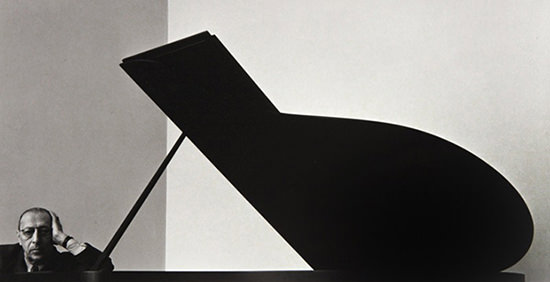Arnold Newman is widely renowned for pioneering and popularizing the environmental portrait. With his method of portraiture, he placed his sitters in surroundings representative of their professions, aiming to capture the essence of an individual’s life and work. Though this approach is commonplace today, his technique was highly unconventional in the 1930s when began shooting his subjects as such. He is also known for his carefully composed, abstract still lifes.
Born in Manhattan, Newman grew up in Atlantic City, New Jersey and later moved to Miami Beach, Florida. In 1936, he studied painting and drawing at the University of Miami. Unable to afford continuing after two years, he moved to Philadelphia to work for a studio, making 49-cent portraits in 1938.
Newman returned to Florida in 1942 to manage a portrait studio in West Palm Beach. Three years later, he opened his own business in Miami Beach.
In 1946, Newman relocated to New York, opened Arnold Newman Studios and worked as a freelance photographer for Fortune, Life, and Newsweek. Though never a member, Newman frequented the Photo League during the 1940s.



My chosen image:

The pictures shows an old man, sitting right at the front of the picture, looking into the camera while resting his chin on his crossed over fingers. Behind him, looks like a train station or factory, with machinery placed everywhere, and lights on the ceiling going back in a straight line. The image itself seems to be rather symmetrical, he’s sat in the middle of the image at the front, behind hims seems to be a window or doorway of some sort which almost resembles a boarder, and the lights and beams on the ceiling go down in straight parallel lines.
The man in this picture is Alfred Krupp, a German industrialist who supported the Nazi party and profited from the use of slave labor during World War ll. Despite being convicted of his crimes and sentenced to 12 years in prison, he was pardoned and only served the minimum of 3 years. In 1963, Newsweek magazine commissioned Arnold Newman to take portrait photographs of Krupp. Originally turning down the offer, he came to accept after being reassured by the editor, but promised to make Krupp look like the Devil. After travelling to Frankfurt, associates of Krupp decided to cancel the photo shoot, due to Newman looking a ‘bit Jewish’. In order to save the shoot, he demanded that his portfolio be shown to their boss, and it worked. The photo shoot took place in Kruppworks factory, and Newman used lighting and the scenery to portray Krupp as an evil man, with ghastly shadows and a green colour cast. Thankfully, the time it took to get the photos developed gave him time to fool Krupp and his associates, as they would have been furious with the outcome.
Lately people have been labeling my Krupp picture as the greatest photographic “knife job” ever done on anybody. But I’m not so sure. I am convinced that any photographic attempt to show the complete man is nonsense. We can only show, as best we can, what the outer man reveals. The inner man is seldom revealed to anyone, sometimes not even the man himself.
Krupp was a very evil man. You can read all about him in several books, especially the Arms of Krupp by Manchester. Krupp claimed during the Nuremberg Trials that he never knew Hitler and that he was a child at the time. This was bullshit! He grew up supporting Hitler. He married one of the Krupp women and Hitler allowed him to adopt the Krupp name.
He ran the Kruppworks using slave labor. He fed them half the calories Hitler allowed for no reason other than there was so much slave labor available. So what? If they got too weak to work he just simply slipped them off to Auschwitz and the gas chambers. Krupp still had slave labor living in his castle at the time I photographed him!
Later on in the War he built factories right next to the concentration camps where all he had to do when they got too weak to work was walk them into the gas chambers. It was that simple. This “slave labor” were people like you and I. ~ Arnold Newman
